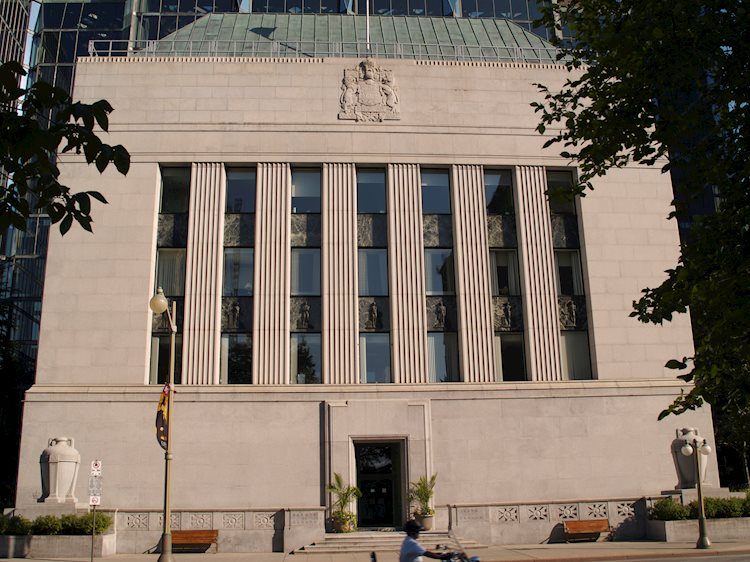On Wednesday, October 28 the Bank of Canada (BoC) is set to leave its interest rate unchanged at 0.25% and publish new forecasts in its quarterly Monetary Policy Report at 14:00 GMT. Governor Tiff Macklem and his colleagues will likely address the impact of coronavirus concerns on the economy. As we get closer to the release time, here are the expectations as forecasted by the economists and researchers of seven major banks, regarding the upcoming announcement. The USD/CAD pair is trading with a mild positive bias above the 1.32 ahead of the event.
ING
“The Bank of Canada policy meeting will deliver no additional stimulus with the policy rate left at 0.25%. The economy likely expanded at an annualised rate in excess of 40% in 3Q20 having contracted 38.7% in 2Q20 while the labour market has seen nearly 2.3 million of the 3 million jobs lost in March and April recovered. Inflation remains low though and like the US Federal Reserve, we expect Canada’s central bank communique to stress there is little prospect of any policy tightening anytime soon.”
TDS
“We expect the overnight rate to remain unchanged at 0.25% with no substantive change to the Bank’s forward guidance, but the October MPR will be an important demarcation point as the Bank sets out its path for 2021 and beyond.”
NBF
“With the economy still in need of stimulus, and with policymakers reluctant to bring their main tool into negative territory, we expect rates to remain at the effective lower bound. Turning to QE, the current C$5 billion weekly purchase pace is proportionally much more aggressive than what the US Federal Reserve Board is doing. While we understand the merits and benefits of the program, it’s not necessarily apparent that an already elevated BoC ownership share needs to continue to march higher, particularly if it means distorting/impairing secondary liquidity. The obvious question that follows is: when should the BoC taper? To us, an announcement at next week’s monetary policy meeting wouldn’t come as a huge surprise. The central bank may also choose to wait for the Federal government’s fiscal update this fall, which promises to set out not just a near-term deficit target but medium-term thinking on Ottawa’s fiscal path. If super-sized deficits are with us for longer, then the case for maintaining QE closer to the current pace would presumably hold more weight.”
RBC Economics
“We expect the central bank to bump up its Q3 GDP growth assumptions in the Monetary Policy Report update Wednesday. More attention will be paid to the bank’s expectations for the economy beyond that given the resurgence in COVID-19 – and certainly, there are limits to how much it can recover while the threat of the virus remains. The central bank assumed a 2% increase in Q4 GDP in their last ‘central tendency’ forecast, slightly above our own current tracking for a 1% increase. The early recovery in consumer spending was supported by unprecedented amounts of fiscal and monetary stimulus. And low-interest rates have clearly played a role in the rebound in housing markets. But the recovery in spending on services has been much slower, and that has also been weighing on inflation. We expect the BoC to remain focused on economic growth rather than near-term inflation concerns, and look for exceptionally low-interest rates to be maintained for the foreseeable future.”
CIBC
“The BoC has shown no inclination to try an even lower policy rate. While there’s a case to be made for dialing back the volume of QE, they likely won’t want to risk announcing anything that could be perceived as reducing stimulus until the virus calms down a bit. Look for just some tinkering with the list of what they buy in the market.”
Rabobank
“We expect the Bank of Canada to leave the policy rate unchanged at 0.25%. We expect the policy rate to remain at 0.25% at least through 2022. Bond purchases are likely to remain at a minimum of CAD5 B a week but we remain of the view that this might need to be increased further down the line. This decision will be accompanied by a new Monetary Policy Report outlining the Bank’s latest economic projections. We do not expect any fireworks at this week’s meeting and with rates at the front-end of the curve effectively anchored for at least the next couple of years, rate differentials are unlikely to prove a driver of USD/CAD anytime soon. Broad-based risk sentiment remains the key driver of USD/CAD which leaves the BoC sitting in the backseats of the USD/CAD car rather than actually driving the vehicle.”
Citibank
“Citi analysts do not expect any change. Citi’s base case is that BoC’s next step will likely be to remove accommodation.”
